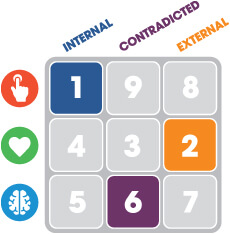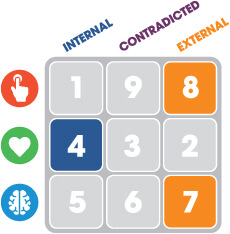The Centers refer to one of the primary triads or fractals within the Enneagram. This triad breaks the nine points into three centers that are potentially expressed in three different ways for each individual.
Each of the centers offer us a point of contact through our sensations which enables us to be present. This requires a deepening of our relationship with all three of our centers of intelligence. As we become present to the intelligence of a center, we integrate and express ourselves at a higher level of development. At this higher level the center is transformed from the expression of action, feeling and thinking to a higher-order of body, heart and head centered intelligence.
Some alternative names authors give to the centers:
Hands
Instinct
Body
Gut
Heart
Emotion
Relationships
Purpose
Head
Logic
Brain
Information
There are different opinions regarding the centers and the way in which they relate to the nine Enneagram points. We would like to explore the centers through the lens of the fractal pattern that is structurally embedded in the Enneagram. We have observed three different yet equally valid ways of working with and interpreting the centers.
Interpersonal Center: How we show up and are experienced in the world
Read More about Interpersonal CentersTransformational Center: A developed Center after deep work with mindfulness and presence
Read More about Centers of IntelligenceIntrapersonal Center: The issues each Enneagram domain has with the Centers
Read More about Intrapersonal CentersThe first perspective relates to the external world and how participation in the world is perceived by others. This perspective of the centers is somewhat behavioural in nature and is determined by how one interacts with others.
Clearly we all have the ability to act, feel and think. However, the energy and nature of one's interaction with others may lead to people experiencing one as more of a thinker, more emotional or more of a doer.
The interpersonal expression of the center is not necessarily linked to Enneagram type. This presents the possibility that some individuals who resonate with Enneagram 1, for example, may be expressing themselves as "thinkers" in the world, whereas another may be more emotional or more action-oriented, regardless of the fact that Enneagram 1 has a structural or intrapersonal position on the Enneagram in the action center. The interpersonal center-expression can lead to mistyping of self or mistyping by others if one confuses the interpersonal expression with the intrapersonal expression of the center.
From a growth and development perspective, the center that we are most likely to show others through our interactions, is often out of balance or unhealthy in its expression in relation to the other centers. A highly emotionally expressive individual is more likely to make some decisions without due consideration for facts and objective analysis and may override or ignore signals from the body or gut that their course of action is potentially problematic. Likewise, an individual who is highly action-oriented in their expression in the world may not pay sufficient attention to careful planning or the impact of their decisions on others and may rush into the premature implementation of impulsive decisions. An individual who is highly thinking-oriented may fall into "analysis paralysis" and struggle to move to action or may engage in a cold and emotionless way with others.
As the interpersonal center expression drives behaviour, others are able to give us valuable feedback with regards to how they perceive us. This use of the center is not directly correlated to the invisible intentions and the psychodynamics of type (although these patterns still influence behaviour), but rather by how we behave in the world.
Dominant Action Center is Expressed as 'hot' energy and relates to movement, action, instinct and physical sensations. People with strong access to their action center are energetic and alive, tuned into both their instinctive voice and the external environment. At an emotional level, the gut or action center is associated with anger in various forms and may be experienced as aggressive by others. At an unproductive level, excessive and unfocused action is often a defence or resistance to thinking or engaging. When expressed intelligently, the action center brings gifts of energy, decisiveness and power.
Dominant Feeling Center is Expressed as 'warm' energy and relates to the gifts of emotional self-awareness, connection and relationships. The feeling center brings open-heartedness, enabling us to connect to the needs and feelings of others as well as ourselves. Individuals with a highly expressed feeling center tend to be inclusive and collaborative when solving problems. Taken too far, excessive feeling can display as over-sensitivity, volatility or emotional manipulation. When the feeling center is expressed intelligently it is empathic, receptive and authentic, able to give and receive feedback and feelings without losing balance.
Dominant Thinking Center is Expressed as 'cool' energy and relates to rationality, information, ideas, planning and prioritising. People who are predominantly thinking-centered tend to excel at analysing issues and generating ideas, based on a solid understanding of the facts. An over-reliance on the thinking center may lead to 'analysis paralysis', over-planning and delaying decisions in an attempt to control things, or simply a busy mind full of worry, doubt and criticism. When expressed intelligently, the thinking center brings a quiet clarity and curiosity, able to reflect deeply and also to move to decisions and action.
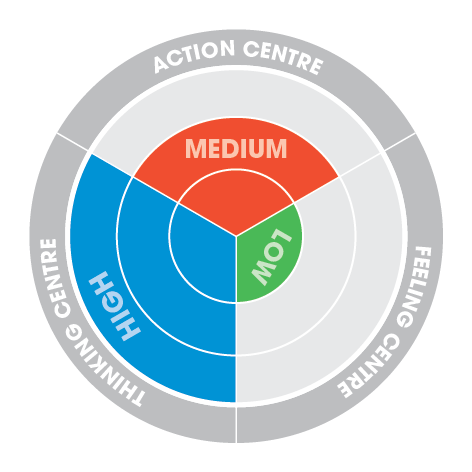
“ It has, I think, long been debunked that just because a person's ennea-type is formed from a particular Center that that is the primary Center they use. For example, many 9s are not so much in touch with their body center; many 9s relate more to the heart center and some to the head center. Many 3s do not relate to being heart-centered and some don't appear this way either.”
Ginger Lapid-Bogda Enneagram in Business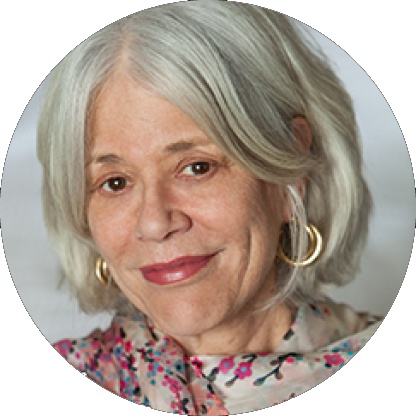
Why we need Claudio Naranjo
“ For the record, what we teach at Enneagram Institute is that no type is a center; and triads and centers are not the same. We teach that the types in each triad represent ego-identification with particular sets of primary issues related to the centers but that all people have these issues to some degree. Also I remind people that it is silly to say "I am a heart person" or a "head person" etc. I ask why we would want to be a third of a person? And yes--I feel strongly that the whole point of the system is the harmonization of the centers ”
Russ Hudson Enneagram Institute
Source Facebook
Grounded and alive body
Receptive, open and authentic heart
Quiet, spacious and trusting mind
This perspective is beautifully positioned by author Roxanne Howe-Murphy (2013) as the practice of presence which enables us to access each of the centers as a center of intelligence. A center becomes 'intelligent' when we are present to it in a grounded, open-hearted and clear way. This kind of presence is not necessarily a pleasant, ephemeral and disconnected or trance-like state, as Howe-Murphy notes there are many misconceptions regarding what it means to be present.
Each of the centers offer us a point of contact through our sensations which enables us to be present. This requires a deepening of our relationship with all three of our centers of intelligence. This deepening can be seen as analogous to the levels of development within each Enneagram type. As we become present to the intelligence of a center, we integrate and express ourselves at a higher level of development. At this higher level, the center is transformed from the expression of action, feeling and thinking to a higher order of body, heart and head-centered intelligence.
To access the intelligence of each center starts with embracing practices that enable an individual to get in touch with each center in an intelligent manner, and to make this part of their way of being in the world. At a more advanced level, transforming or healing deeply entrenched patterns may be required.
A particular pattern that is useful to focus on relates to bringing balance across the centers. For example, an individual who is dominant in the expression of their feeling center at an interpersonal level is likely to benefit significantly by developing their body and head-centered intelligence so as to transform the expression of the heart center. These intelligences also build on each other: presence of body opens the door to presence of heart which in turn opens the door to presence of mind.
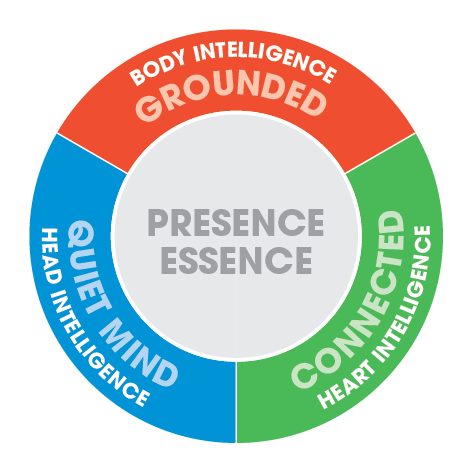
This perspective can create confusion in most teachings of the Enneagram. Originally, Claudio Naranjo taught that the Enneagram types have three sets of emotional issues in common.
Oscar Ichazo also taught that a person has a fixation in each of the three triads and called it Tri-Fix. Cathrine and David Fauvre in more recent years called it TriType.
The iEQ9 refers to this as the Triadic Styles.
This means each type have specific ISSUE or challenges to resolve in relation to their center and the emotional theme associated with that center.
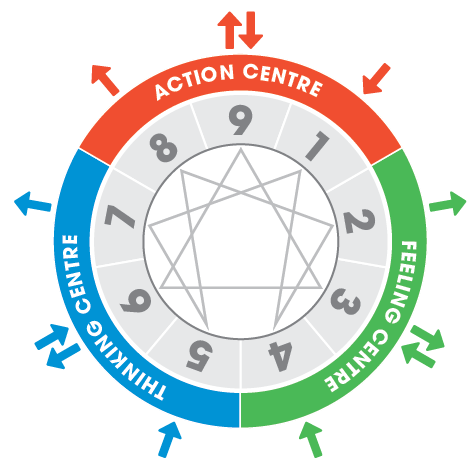
Enneagram types 8, 9 and 1 Issues with: Anger/Control and the Body
Enneagram types 2, 3 and 4 Issues with Shame/Sadness and the Heart
Enneagram types 5, 6 and 7 Issues with Fear/Cynicism and the Head
In addition to the issues or challenges of each center as set out above, the three patterns listed below are present as repeat energies in each of the three center-clusters - three energies are, therefore, repeated three times through the three centers. Each of the three patterns or energies is matched to a particular Enneagram type situated within one of the three center-clusters:
The centers offer a pathway to explore how a particular emotional theme plays out in our lives from an intrapersonal perspective. It describes how the center's emotional theme is constructed within us. It has a clear and direct relationship with the psychodynamics of a person's Enneagram type. This may or may not be visible to others around us, although the likelihood of others being aware of this intrapersonal process will increase for the externalised or projected pattern or energy within each of the centers.
This is a static or structural perspective. The individual's Enneagram point of resonance determines the center into which they fall. In other words, people who resonate with Enneagram 8 fall into the action center and will need to work through the issues they have regarding externalising or projecting anger - in the same way that people who resonate with Enneagram 5 need to work through issues they have regarding the introjection or internalisation of anxiety. The structure of the Enneagram determines the correspondence between type and the intrapersonal expression of the center.
